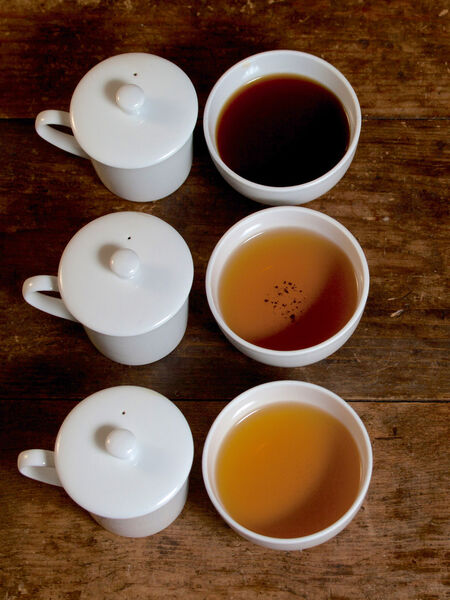Professional Tea Cupping - Part 1

Tea Cupping is the Foundation of Tea SELLING!
Cupping, the procedure for professional tea tasting, is critical to educate your palate, increase your knowledge of tea, and to sell tea because customers love to learn all the nuances you’ve discovered about your inventory. The most vital piece of equipment in professional cupping is the classic white porcelain tea tasting set with serrated brewing cup with matching tasting cup or a glass tasting set that clearly reveals the color of each brewed tea.
HOW TO USE A PROFESSIONAL CUPPING SET:
Practice using your brew cup by pouring water into it just UNDER where the serrated edge begins. Cover the brewing cup with its lid and place the cup in a horizontal position over the tasting cup. To do this easily, lift the brewing cup with the handle, then place your thumb tightly on top of the lid. Hold the tasting cup (bowl) right next to the brewing cup before placing the brewing cup horizontally, serrated edge down onto the tasting cup. The water should flow out immediately through the grooved teeth. If done correctly, the lid knob and brew cup can rest on the bowl cup while the tea pours into the bowl. Once the brew cup is empty, carefully pick it and the lid up while still in pouring orientation to get every drop, then set it down on the table.
Use room temperature water to practice, then graduate to heated water. Repeat this several times until you feel confident you can do it quickly and smoothly without spilling the water on you or anywhere else but the tasting cup. (Or dropping the brew cup!)
OTHER EQUIPMENT TO USE:
For cupping with staff, keep a holder of extra spoons and a tray of tasting cups. Each person should have their own porcelain spoon to scoop out a portion of tea liquor from the brewing cup and pour that tea into her own cup, then taste from the cup. This is more sanitary and quite efficient. Porcelain spoons and small-sized (2-3 oz) cups are readily available wherever Chinese culinary utensils are sold. An alternative tasting cup could be Taiwanese-style thimble cups. Avoid metal spoons as they can taint the flavor of the tea.
Optional equipment: Instant read thermometer if you do not have a variable temperature tea kettle; large bowl for hot water to rinse off cups and spoons, bamboo tongs to securely dip the spoons or cups into the hot water, paper or linen towels to wipe down the rinsed utensils, and large cloth-lined basket to place used items to carry to the kitchen to clean up and store.
Timer, medium-sized bowl for a spittoon, tasting spoon, tea tasting sets, each with a brewing cup, lid, and tasting cup. Use one set for each tea you are tasting so that you can not only taste, but re-taste to compare. Add a measuring cup, measuring spoon (or tea scoop or scale,) and printouts of your own grading templates listing tea-tasting characteristics most important for your buying decisions.
SETTING UP FOR A PROFESSIONAL CUPPING SESSION:
Be sure to practice using your brew cups and stay tuned for PART 2!

